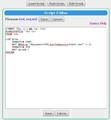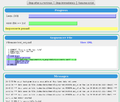Sequencer Page: Difference between revisions
Jump to navigation
Jump to search
(Created page with "<div style="column-count:4;-moz-column-count:4;-webkit-column-count:4"> * Midas Documentation * Feature Listing * Application_lis...") |
No edit summary |
||
| Line 23: | Line 23: | ||
= Purpose = | = Purpose = | ||
The purpose of the [[mhttpd]] Sequencer Web Page to display | The purpose of the [[mhttpd]] Sequencer Web Page to provide a visual display for the [[Sequencer]]. Using the Sequencer Page, Sequencer scripts can be loaded, edited and run. | ||
= Access to the Sequencer Page = | = Access to the Sequencer Page = | ||
The Sequencer Page is displayed by clicking on | The Sequencer Page is displayed by clicking on {{Button|name=Sequencer}} button on the mhttpd [[Status Page]] or other [[mhttpd]] web page. | ||
;Note | ;Note | ||
| Line 34: | Line 33: | ||
= Features of the Sequencer Page = | = Features of the Sequencer Page = | ||
The Sequencer Page takes | The Sequencer Page takes its parameters from the [[/Sequencer ODB tree]]. Sequencer scripts can be loaded and run from the Sequencer Page. A visual editor is provided to edit scripts. A display is provided showing the progress of a running script, and the last few Midas messages are also shown (Figure 5). | ||
== How to input and run a Sequencer Script == | |||
See [[Sequencer|Sequencer Commands]] for the list of commands recognized by the Sequencer. | |||
<ul> | |||
<li>Press {{Button|name=Sequencer}} on [[Status Page]]. The first time the button is pressed, the Sequencer Page will appear as in Figure 1, where no load file has been specified.</li> | |||
;Note | |||
:The directory path where the sequencer files will be saved is set by the ODB parameter [[/Sequencer ODB tree#Path|/Sequencer/State/Path]]. | |||
<li>Either</li> | |||
<ul> | |||
<li> press {{Button|name=Edit Script}} and input a new test sequence (Figure 2).</li> | |||
<li> save the script by pressing {{Button|name=Save}}. You will be asked for a file name. </li> | |||
</ul> | |||
<li>Or </li> | |||
<ul> | |||
<li>load an existing script using {{Button|name=Load Script}} as in Figure 3.</li> | |||
</ul> | |||
<br> | |||
<li> Press {{Button|name=Start Script}} button to start the script. <br> | |||
In this example, the script contains an error that prevents the script from running (Figure 4)</li> | |||
<br> | |||
<li> The script is edited by pressing {{Button|name=Edit Script}}, and the error corrected.</li> | |||
<br> | |||
<li> Now the script will run when {{Button|name=Start Script}} is pressed. A visual status is displayed in the Progress window, and the current position in the sequence file is also highlighted (Figure 5).</li> | |||
<br> | |||
<li> The sequencer can be paused by pressing the {{Button|name=Pause Script}} button (Figure 6).</li> | |||
<br> | |||
<li>The progress window will indicated when the sequencer is finished (Figure 7).</li> | |||
</ul> | |||
;Click on a thumbnail to enlarge | |||
<gallery> | |||
File:sequencer_noscript.png|Figure 1: Initial Sequencer page | |||
File:sequencer_scripteditor.png|Figure 2: Editing a Sequencer script | |||
File:sequencer_filelist.png|Figure 3: Select a Sequencer file | |||
File:sequencer_error.png|Figure 4: There is an error in the script | |||
File:sequencer_running.png|Figure 5: Sequencer is running | |||
File:sequencer_paused.png|Figure 6: Sequencer is paused | |||
File:sequencer_finished.png|Figure 7: Sequencer is finished | |||
</gallery> | |||
[[Category: mhttpd]] | [[Category: mhttpd]] [[Category: Sequencer]] | ||
Revision as of 18:48, 2 July 2015
Links
Purpose
The purpose of the mhttpd Sequencer Web Page to provide a visual display for the Sequencer. Using the Sequencer Page, Sequencer scripts can be loaded, edited and run.
Access to the Sequencer Page
The Sequencer Page is displayed by clicking on Sequencer button on the mhttpd Status Page or other mhttpd web page.
- Note
- If the Sequencer button is not present on the Status Page, it may have been suppressed.
Features of the Sequencer Page
The Sequencer Page takes its parameters from the /Sequencer ODB tree. Sequencer scripts can be loaded and run from the Sequencer Page. A visual editor is provided to edit scripts. A display is provided showing the progress of a running script, and the last few Midas messages are also shown (Figure 5).
How to input and run a Sequencer Script
See Sequencer Commands for the list of commands recognized by the Sequencer.
- Press Sequencer on Status Page. The first time the button is pressed, the Sequencer Page will appear as in Figure 1, where no load file has been specified.
- Note
- The directory path where the sequencer files will be saved is set by the ODB parameter /Sequencer/State/Path.
- Either
- press Edit Script and input a new test sequence (Figure 2).
- save the script by pressing Save. You will be asked for a file name.
- Or
- load an existing script using Load Script as in Figure 3.
- Press
Start Script button to start the script.
In this example, the script contains an error that prevents the script from running (Figure 4) - The script is edited by pressing Edit Script, and the error corrected.
- Now the script will run when Start Script is pressed. A visual status is displayed in the Progress window, and the current position in the sequence file is also highlighted (Figure 5).
- The sequencer can be paused by pressing the Pause Script button (Figure 6).
- The progress window will indicated when the sequencer is finished (Figure 7).
- Click on a thumbnail to enlarge






